Bartram Collection includes rare Indian artifacts
Team Radio Marketing Group - February 24, 2017 11:11 am

A special collection at Marland’s Grand Home recently has attracted the attention of a Washington museum curator.
Barbara Brotherton, Native American exhibit curator of the Seattle Art Museum, recently visited Marland’s Grand Home to assess the Bartram Collection of northwest tribal artifacts.
During her visit, Brotherton meet with Jayne Detten, Marland Mansion and Marland’s Grand Home Assistant Director, and two of the Bartram family members, Mary Lou Bates, a Bartram granddaughter and Jill Perry, a great-granddaughter.
Family members passed on stories of Fred Bartram’s early years as a teacher at the Quileute Reservation. Brotherton was able to share Quileute customs and ways with the family to help them more fully understand the relationship their grandfather had with the people he taught and mentored.
An expert in her field, Brotherton plans to write a book on the Quileute tribe soon.
Brotherton plans another trip back to Ponca City in the near future to further study the collection, doing research for her book and the Seattle Art Museum.
Fred Bartram, born November 3, 1876, in Sumner, Ill., was the eldest of five children. His mother died very young, leaving him to help raise the other four siblings.
During those years he taught school in Illinois and Missouri. In the early 1900s, he joined the Department of the Interior, United Indian Service, to teach students on Indian reservations in the northwest United States. In the years that followed, he was assigned to reservations in Washington, Montana, and Arizona.
Fred met and married a young teacher, Blanche Adamson, a fiery Irish redhead from Kenosha, Wis. Their first child, Mary, arrived in 1910 on the Quileute Reservation in La Push, Wash. She was the first child of Caucasian descent born on that reservation.
When the Bartrams were transferred to another post, the tribe wanted little Mary to remain with them since she was born on the reservation. If the Bartrams had agreed, one of the Indian families would have the privilege of adopting her. However, the Bartrams did not agree, and the Quileute reluctantly allowed her leave with her parents.
During his teaching years, Fred Bartram interacted with the Quileute and Siletz tribes in Washington and Oregon, then the Cheyenne and Sioux tribes in Montana, and the Hopi and Navajo tribes in New Mexico and Arizona. These tribes gifted the Bartrams with more than 1,000 artifacts. The Bartrams’ favorite and largest item was a five foot tall seal god, which was “dispirited” before its journey off the reservation.
The Bartrams’ final assignment was to be on the Ponca Reservation at White Eagle. While at that location in 1916, their second child, Babe, was born. She was very frail and died in the flu epidemic of 1918.
This event changed the family’s lives forever; Blanche Bartram then told her husband that she no longer wished to travel around the country. Fred Bartram left the Indian Service and became an accountant for Marland Oil Company.
The Bartrams made a permanent home at 713 E. Grand Avenue in Ponca City, not far from the E.W. Marland estate to the east. In their home, the family displayed most of the Indian items and hosted school groups to tour.
Fred Bartram would regale the students with tales of the past referencing Indian crafts and customs. Layoffs, however, eliminated his job after the Marland Company merged with Continental Oil in 1929.
The Bartrams donated their items to the Ponca City Indian Museum in the 1950s. The donation included hundreds of Hudson Bay trading beads, baskets, wood carvings, and tribal tools from the Quileute and Siletz tribes.
Also donated were leather clothing, tribal tools, and ceremonial items from the Cheyenne, Arapaho, Sioux, and Blackfoot and beautiful pottery, rugs, baskets, and kachinas from the Hopi and Navajo.
Bartram also bequeathed his old carpentry tools and camera equipment, all used on the reservations where he was stationed.
Fred Bartram died following his generous donation in the 1960s. Today, Marland’s Grand Home displays most of the Bartram Collection in the Basket and Pottery and the Matriarchal and Patriarchal exhibit rooms. Some of the more delicate items remain in storage. Photos of his entire collection can be viewed in a large notebook in the exhibit area.
Marland’s Grand Home is open from 10 a.m. to 5 p.m. Tuesday through Saturday. For more information, visit marlandgrandhome.com or call (580) 767-0427.



